|
Ship's
Log - Past Trips
Below is the story of our October 2001 trip to bring Landfall
from Olympia, Washington, where we found her, to our then-home port of Half Moon Bay,
California. The next story describes how Landfall got from Half
Moon Bay to Mobile, Alabama, our next home port.
Olympia, Washington to Half Moon Bay,
California
We were living aboard Odyssey, our Hunter 36 sailboat, in Half
Moon Bay, California, when we found Landfall listed for sale.
She was listed as a "1978 Tiburon 36 center cockpit, cutter-rigged
ketch". This means she was built in 1978, is 36 feet long, and
the cockpit is in the middle of the boat, rather than in the stern
like many boats. It also means she is a sailboat with two masts, one for the
mainsail and one for the mizzen sail, and she has two sails on
the bow, a jib and a staysail. We knew that she was our ultimate
blue-water ocean cruising boat. She was docked in Olympia, Washington,
at the very south end of Puget Sound. We quickly made arrangements
to fly up to see her.
It was love at first sight. After several small repairs, she
was ours. We quickly completed preparations to sail her home to
Half Moon Bay, a trip of over 1,000 miles. It was already fall,
and we needed to have her home before the harsh Pacific Ocean
winter storms began.
After studying many navigation charts we decided on a two-leg
trip. First, a quick weekend trip, north from Olympia, up Puget
Sound, and around to Port Angeles. Then we would go back to work
for a week. Then the next week, we could take some vacation time
to make the long Strait of Juan de Fuca and Pacific
Ocean leg to Half Moon Bay, a seven day and six night trip, non-stop.
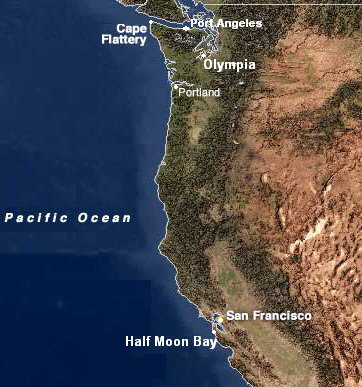
The first leg began on a Saturday morning, a lot later than we
had planned. We had to wait for hours for the dense South Puget
Sound fog to lift. While waiting, we practiced docking maneuvers.
Well, to be honest, we actually tried to leave twice, but the
fog was still too thick, and we had to turn back. Every time we
did, we had to practice docking the boat! When the fog finally
lifted, it took us the rest of the day to motor in flat-calm seas
up toward Seattle.
We had one panic-party when the engine alarm began screaming.
We were halfway up the narrow Colvos Passage between Vashon Island
and the Kitsap Peninsula. We turned the engine off and drifted
in the deep water, warily eying the nearby shores. Going aground
in a full keel boat is a very bad idea. We wanted to avoid that
at all costs.
After checking every source of the alarm we could think of, we
finally decided it was the alarm itself that was faulty, so we
disconnected it. Not the solution we had expected, but it was
certainly the most convenient one. We
fired up the engine and plowed ahead, eyes nervously scanning
the gauges for the rest of the day.
We anchored Landfall off the south side of Blake Island, a
State Park in the middle of Puget Sound near Seattle. We arrived
just as the autumn darkness fell. We found a spot not too close
to the other boats anchored there, and laid out 120 feet of chain
in 20 feet of mid-tide water. Two, 200-foot ferry boats crossing
Colvos Passage every hour rocked us with their wakes until late
into the night.

The morning sky was lighting up clear and cold as we made coffee
and prepared to haul anchor. We'd planned a full day of motor-sailing
against a north wind, aided by a strong ebb current. We wanted
to arrive in Port Angeles by sundown. If we missed our goal, we'd
miss our flight back to San Francisco. We got busy.
A half-hour after hauling anchor we could see the sun rising
behind downtown Seattle, several miles off to starboard. Even
with the engine running, with the current against us, it was slow
going. But the current was moving, too, and we finally caught
up with each other. With that favorable ebb current we were pulled
along quickly. In the thick of the ebb, Landfall was easily making
9-10 knots over the ground.
Landfall slipped into Port Angeles on schedule, though just barely,
and we tied her up to the dock just as the last light of dusk
faded into a cold starlit night.
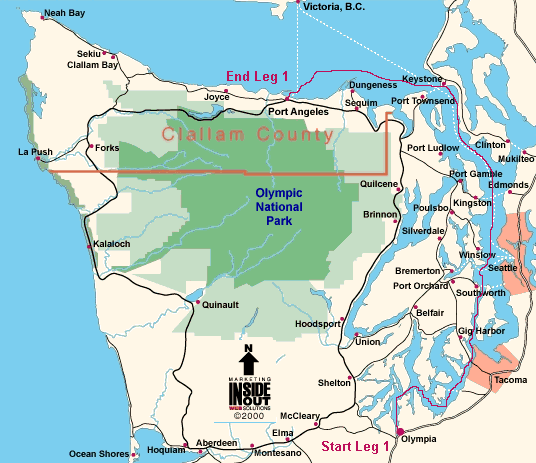
Our good friend Steve put us up for the night and then took us
to the tiny Port Angeles airport in the dark hours of the next
morning. That week, while we worked in California, Steve ran some
essential errands for us: filling the propane tank, buying a water
hose and filling the water tanks, and doing some provisioning
from a list we'd left with him. He also found a used boombox and
lent us some of his tapes. Landfall had no stereo, and Steve,
a musician, just could not imagine anyone living for a whole week
without tunes.
The day before leaving on the second leg was filled with final
preparation chores: fresh food provisioning (which we ended up
not eating, for the most part, due to the weather conditions);
hooking up an emergency radio antenna; trying, unsuccessfully,
to hook up the new radar antenna, and in general getting more
familiar with Landfall's systems.
When the fuel dock opened the next morning we were first in line,
fueled up, and were off. Our course took us west from Port Angeles
on the 20 mile wide Strait of Juan de Fuca. The strait, 80 miles
long, separates Washington from British Columbia and marks the
international boundary between the United States and Canada. It's
a very busy channel, with hundreds of huge ships coming from or
going to Seattle, Washington and Vancouver, British Columbia,
Alaska, the Pacific west coast and the Far East. Our biggest navigational
chore all day was just trying to stay out of the big ships' way!
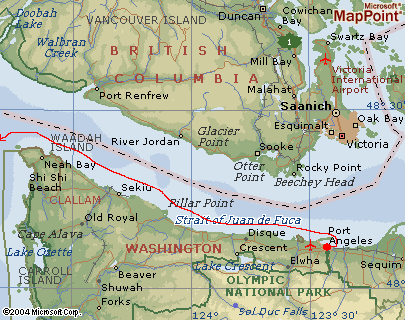
We reached the lumpy Pacific Ocean entrance to the Strait just
before sunset, and once past the boiling waters of Cape Flattery,
turned southwest. From there, and for five hours more, three sets
of conflicting swells jostled Landfall. We felt like an errant
tube of Chapstick floating in the wash cycle.
A huge orange full moon rose from behind the Olympic mountains
as the glorious sunset colors faded on the endless horizon to
the west. And while admiring all that stunning beauty, Capt. Sharon
felt the first pangs of a seasickness that was to last for the
next 36 hours. Oh, man!
We wanted to get offshore quickly, to avoid shipping traffic,
fishing fleets and a rocky lee shore. As we sailed further southwest
through the moonlit night and the breaking dawn, beyond sight
of land and past the shipping lanes, the seas became more regular
and the wind began to fill. And fill. And fill. And for the next
two days, the seas continued to build.
By the third day, about 120 miles offshore and 350 miles south
of the Strait, we had reefed down the main and mizzen sails entirely
and completely furled in the jib. With just the storm trysail
straining in the 40 knot winds, we were surfing down 8-14 foot
waves. Flying down those bigger waves at 11 knots was better than
an E-ticket ride at Disneyland, and Landfall was enjoying every
second of it. And, so were we!
It was impossible to cook in those conditions. Anything would
have flown off the counter while trying to prepare it and flown
off the stove while trying to cook it. The waves surging on Landfall's
starboard stern quarter were rocking Landfall like some evil nanny
trying to hush a crying child. Fortunately, we had "MREs," Meals
Ready to Eat, the kind of food they feed our military troops in
combat. Though our conditions were far less hazardous than war,
we were simply unable to cook, and very grateful for the hassle-free,
zip-and-squeeze rations.
We did brave scaldings to boil water for hot coffee and tea,
though. Strong fiddles held the shallowly-filled, tall, covered
pot on the stovetop, and gimbals kept the stove mostly level and
the hot water (mostly) in the pan. We quickly learned to pour
everything over the sink, as we tried to match the rocking of
the boat with the trajectory of the pouring liquid. We also learned
to heat more water than we thought we'd need, on account of spillage!
Close encounters with Pirates?
While underway, twice, in the dark hours of the early morning,
we had close encounters with other ships. On our third night out,
a large ship began to chase us. As its lights grew closer, we
altered course to get out of its way. But it followed our every
move, coming closer and closer. We'd heard of pirates on the high
seas, but we hadn't expected them off the coast of Oregon! The
looming high bow surged up close on our stern, someone shined
a huge spotlight on us, and then it bore away, leaving us frightened
and confused. In the reassuring light of the next day, we speculated
that perhaps the ship's captain had simply been concerned about
us. We were a small boat in a big sea. We were over a hundred
miles offshore. We were unseasonably late for the southbound migration.
It's possible. And as the sun shone brighter, it seemed ever more
probable. But we'll never know.
A couple of nights later, approaching the Continental Shelf
in the black of night, the encounter was probably more our fault.
We'd come upon a fishing fleet, lights ablaze and dragging huge
nets. Although we tried to avoid them, it was hard to tell which
way they were moving in relation to our course. Only when we were
too close did we realize that one ship was headed straight toward
us, on a collision course! A hasty surge of Landfall's 40hp engine
and a hard turn of the wheel brought us slowly away, but only
in the nick of time. Once again, with shaky knees, we realized
the hazards of encounters on the high seas.
The Final Leg Home
On the fifth day, as the winds began to moderate and the seas
began to subside, we'd settled into a comfortable rhythm. The
sun was shining. The windvane, which had seemed so intricate and
complicated on the first day at sea, had become a named and trusted
First Mate. We could cook real food, and making coffee involved
no risk at all. A Gray Whale surfaced and exhaled just off our
starboard side. Ahhh...
A day out of San Francisco, the wind died completely. We fired
up the engine and motored on glass-calm seas past the Farallon
Islands, small rocky chunks 50 miles off the coast. The area around
the Farallones is notorious for harsh winds and bad seas, but
it was not living up to its reputation on this day. A small pod
of Pacific White-sided Dolphins came to play with us, their gleaming
white-and-black sleek bodies cruising in our bow wake and fanning
out beside our hull. Frisky, gregarious juveniles leapt out of
the water, crossing under Landfall's bowsprit. We stood above
them, squealing with delight, hoping they would play with us all
day.

Just a little bit further south and we'd be home. We faced a
decision: Do we continue on, knowing we would arrive in Half Moon
Bay after dark, possibly in the fog, and with no radar? Or do
we head back offshore, heave-to, "park the boat" and wait until
daybreak?
We were exhausted after seven days and nights of non-stop sailing,
night watches, and four days of big seas. While it would certainly
be dark when we arrived, the area's lurking fog bank was well
offshore, though there was a risk it could creep in at any time.
We also knew that Half Moon Bay was our home harbor and we'd
sailed into it often. We decided to head to the outer marker and
make a final decision then.
Five hours later, the night was dark, crisp and still clear,
and we let the channel markers guide Landfall to her new home.
California to
Alabama
This is a very short story. We sailed Landfall from Half Moon
Bay to Alameda, on the eastern shore of San Francisco Bay, about
a 6 hour trip.
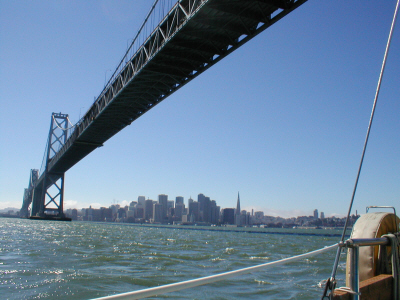
Then, a big crane took the masts off Landfall. A "Travel-lift"
picked her up out of the water, and she was placed on a big flatbed
trailer.
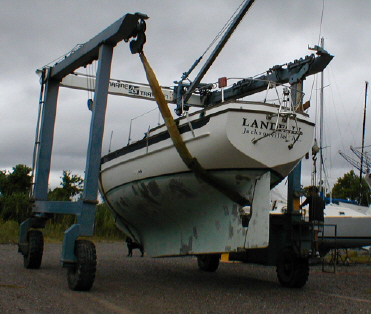
A truck pulled her 2,300 miles across the country, all the way
to Mobile, Alabama. She was put back in the water and her masts
were put back on, and she was ready to go!
|
![]()